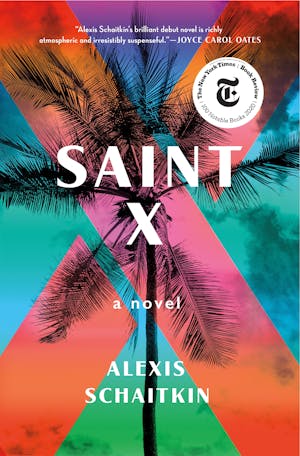INDIGO BAY
BEGIN WITH AN AERIAL VIEW. Slip beneath the clouds and there it is, that first glimpse of the archipelago—a moment, a vista, a spectacle of color so sudden and intense it delivers a feeling like plunging a cube of ice in warm water and watching it shatter: the azure sea, the emerald islands ringed with snow-white sand; perhaps, on this day, a crimson tanker at the edge of the tableau.
Come down a bit lower and the islands reveal their topographies, valleys and flatlands and the conic peaks of volcanoes, some of them still active. There is Mount Scenery on Saba, Mount Liamugia on Saint Kitts, Mount Pelée on Martinique, the Quill on Saint Eustatius, La Soufrière on Saint Lucia and also on Saint Vincent, La Grande Soufrière on Guadeloupe’s Basse-Terre, Soufrière Hills on Montserrat, and Grande Soufrière Hills on tiny Dominica, which is beset by no fewer than nine volcanoes. The volcanoes yield an uneasy sense of juxtaposition—the dailiness of island life abutting the looming threat of eruption. (On some islands, on some days, flakes of ash fall softly through the air, pale and fine, before settling on grassy hillsides and the eaves of rooftops.)
Roughly in the middle of the archipelago lies an island some forty kilometers long by twelve wide. It is a flat, buff, dusty place, its soil thin and arid, the terrain dotted with shallow salt ponds and the native vegetation consisting primarily of tropical scrub: sea grape, cacti, wild frangipani. (There is a volcano here, too, Devil Hill, though it is so small, and the magma rises to its surface so infrequently, that it is useless as both a threat and an attraction.) The island is home to eighteen thousand residents and receives some ninety thousand tourists annually. From above, it resembles a fist with a single long finger pointing west.
The north side of the island faces the Atlantic. Here, the coast is narrow and rocky, the water seasonally variable and sometimes rough. Nearly all of the residents live on this side, most of them in the tiny capital town, the Basin, where cinder-block schools, food marts, and churches mingle with faded colonial buildings in pastel hues: the governor-general’s petal-pink Georgian mansion; the mint-green national bank; Her Majesty’s Prison, eggshell-blue. (A prison next to a bank—a favorite local joke.) On this coast, the beaches’ names bespeak their shortcomings: Salty Cove. Rocky Shoal. Manchineel Bay. Little Beach.
On the south side of the island, the gentle waves of the Caribbean Sea lap against sand fine as powder. Here, resorts punctuate the coast. The Oasis, Salvation Point, the Grand Caribbee, and the island’s crown jewel, Indigo Bay, all of them festooned with bougainvillea, hibiscus, and flamboyant, beautiful deceptions meant to suggest that this island is a lush, fertile place.
Scattered in the sea around the island are a dozen or so uninhabited cays, the most notable of which are Carnival Cay, Tamarind Island, and Fitzjohn (famous, at least locally, as the home of the Fitzjohn lizard). The cays are popular spots for excursions—snorkeling, romantic picnics, guided expeditions through their limestone caverns. The closest of the cays to the main island is the ironically named Faraway Cay, which sits not five hundred meters off the coast at Indigo Bay and which, owing to its nacreous beach, its wild landscapes, and the pristine waterfall at its center, would be a popular destination like the other cays, were it not overrun by feral goats, which survive on sea purslane and prickly pear.
The island’s visitors have little sense of its geography. If asked, most would be unable to sketch its basic shape. They cannot locate it on a map, cannot distinguish it from the other small landmasses that dot the sea between Florida and Venezuela. When a taxi brings them from the airport to their hotel, or from their hotel to a Caribbean fusion restaurant on Mayfair Road, or when they take a sunset cruise aboard the catamaran Faustina, or disembark their cruise ship at Hibiscus Harbour, or when a speedboat whisks them to Britannia Bay to tour the old sugar estate, they do not know if they are traveling north or south, east or west. The island is a lovely nowhere suspended in gin-clear water.
When they return home, they quickly forget the names of things. They do not remember the name of the beach on which their resort was situated, or of the cay where they went for their snorkeling excursion. (The beach there was littered with sand dollars, as if they were entirely unprecious.) They forget the name of the restaurant they liked best, remembering only that it was some exotic flower. They even forget the name of the island itself.
* * *
ZOOM IN closer on Indigo Bay and the resort’s features come into view. There is the long drive lined with perfectly vertical palm trees, the marble lobby with its soaring domed roof, the open-air pavilion where breakfast is served until ten each morning, the spa, the swimming pool in the shape of a lima bean, the fitness and business centers (“CENTRE,” on the engraved placard outside of each; the American guests are charmed by this Briticism, which strikes them as quaint and earnest on this island so distant from England). There is the beach where lounge chairs are arranged in a parabola that follows the curve of the bay, the local woman set up on a milk crate beneath a sun-bleached blue umbrella at the beach’s edge, braiding young girls’ hair. The fragrance is tropic classic, frangipani and coconut sunscreen and the mild saline of equatorial ocean.
On the beach are families, the sand around their chairs littered with plastic shovels, swimmies, impossibly small aqua socks; honeymooners pressed closely together beneath cabanas; retirees reading fat thrillers in the shade. They have no notion of the events about to unfold here, on Saint X, in 1995.
The time is late morning. Look. A girl is walking down the sand. Her gait is idle, as if it is of no consequence to her when she arrives where she is going. As she walks, heads turn—young men, openly; older men, more subtly; older women, longingly. (They were eighteen once.) She wears a long, billowy tunic over her bikini, but she has a teenage knack for carrying it with a whiff of provocation. A raffia beach bag is slung casually over her shoulder. Apricot freckles crowd the milky skin of her face and arms. She wears a silver anklet with a charm in the shape of a star, and rubber thongs on her long, archless feet. Her russet hair, thick and sleek as a horse’s, is tossed into a bun of precise messiness with a yellow elastic band. This is Alison, never Ali.
“Good morning, sleepyhead,” her father says when she reaches her family’s lounge chairs.
“Morning,” she yawns.
“You missed a cruise ship go by right out there. You wouldn’t believe how big that thing was,” her mother says.
(Though the guests at Indigo Bay are apt to complain when these hulking ships lumber into the vista, they also derive a certain satisfaction from these moments, when the bad taste of others reaffirms their own quality—they have not chosen to spend their vacations in the vulgar opulence of a ship with all the beauty of an office park.)
“Sounds riveting.” Alison drags a chair out of the shade of an umbrella and into the sun. From her beach bag she removes a yellow Walkman. She lies down, puts on her headphones, and pulls her sunglasses over her eyes.
“How about a family swim?” her father says.
Alison does not respond. Not pretending she doesn’t hear him over whatever she’s listening to, her father decides, just ignoring him.
“Maybe in a little while everyone will be more in the mood,” her mother says with prodding cheerfulness.
“Hey, Clairey,” Alison says. “I’m going on a treasure hunt and I’m bringing a starfish.”
She is speaking to the little girl sitting in the sand between her mother’s and father’s chairs, who until this moment had been piling sand into small mounds with intense focus.
“I’m going on a treasure hunt and I’m bringing a starfish and a dog,” the little girl says.
She is as peculiar in appearance as her older sister is appealing. Her hair is nearly white, her skin extremely pale. Eyes gray, lips blanched. These features combine to create an impression that manages to be at once arresting and plain. This is Claire, age seven. Clairey, to her family.
“I’m going on a treasure hunt and I’m bringing a starfish, a dog, and a piccolo.”
“A piccolo,” Claire whispers. Her eyes widen with wonder.
The father flags down one of the men who work on the beach. There are two of them, both dark-skinned, in white slacks and white polos with the resort insignia embroidered on the breast pocket in gold thread. The skinny one and the fat one, in most of the guests’ mental shorthand. The man who approaches the family now is the skinny one, Edwin.
When he reaches them, Alison sits up and smooths her hair.
“How are you all doing this morning?” he asks.
“Excellent,” the mother says with a bright display of enthusiasm.
“First time to our island?”
“Yes,” the father confirms. “Just flew in last night.”
The family vacations at a different resort on a different island every winter, weeklong respites from their snowbound suburb that steel them for the remaining months of darkness and cold. They have seen palm trees bent to kiss the sand. They have seen water as pale as glaciers and walked on sand as soft as cream. They have watched the sun transform, at the end of the day, into a giant orange yolk that breaks and spills itself across the sea. They have seen the night sky overcome with fine blue stars.
“Look at our island pulling out she most beautiful day for you.” He gestures generally with his skinny arm at the sky, the sea. “What can I be getting you this morning?”
“Two rum punches and two fruit punches,” the father says.
Alison emits a small sigh.
The skinny one returns some time later. (Too long, the father thinks, as fathers all along this stretch of sand think; the skinny one is a chatterbox, and a dawdler.) He bears a tray of drinks garnished with maraschino cherries and hibiscus blossoms.
“We have a volleyball match this afternoon,” he says. “We hope you will join us.”
“Oh, honey, you would love that!” the mother says to Alison.
The girl turns to face her. Though she wears sunglasses, the mother has no doubt that behind them her daughter’s gaze is withering.
The skinny one claps his hands together. “Excellent! May we count you in, miss?”
The girl adjusts her sunglasses. “Maybe.” (She has developed a talent lately for delivering even the most innocuous words as thinly veiled innuendo. The mother has noticed this.)
“More of a sunbather, are we?” the man says.
Alison’s face turns crimson.
The father reaches into his wallet and pulls a few singles from the thick stack he took out yesterday at the bank. (Was that really just yesterday? Already he can feel the island beginning to work its rejuvenating magic on him.)
“Thank you, sir.” The skinny one tucks the money in his pocket and continues down the beach.
“Nice guy,” the father says.
“Friendly,” the mother agrees.
“Well?” the father says, and raises his glass.
The mother smiles. Clairey stares intently at her cherry. Alison swirls her fruit punch with practiced boredom.
“To paradise,” the father says.
Copyright © 2020 by Alexis Schaitkin






